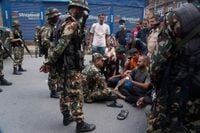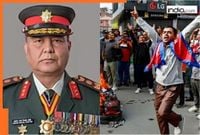In Kathmandu and across Nepal, the early morning of September 13, 2025, brought a palpable sense of relief. After five tense days of curfews, protests, and uncertainty, the Nepal Army officially lifted all restrictive orders, allowing daily life to slowly resume its familiar rhythms. Shops, grocery stores, vegetable markets, and shopping malls that had been shuttered for days reopened, while traffic once again flowed through the city’s streets. The return to normalcy was greeted with both relief and cautious optimism, as the country began to pick up the pieces after a turbulent week that left at least 51 dead and the government in transition.
According to NDTV and Business Standard, the unrest was sparked by a controversial social media ban and allegations of government corruption. The ban, which had been imposed abruptly, triggered outrage among Nepal’s youth—particularly the so-called “Gen Z” generation. Protests erupted on Monday, September 8, 2025, and quickly escalated into violent clashes with security forces. By the time the dust settled, Nepal Police reported that at least 51 people, including an Indian citizen, had lost their lives in the chaos. The violence was most acute on Monday, when demonstrators stormed the office of Prime Minister KP Sharma Oli, blaming him for the deaths of at least 19 protesters during a government crackdown.
Under mounting pressure and facing a country on the brink, Oli resigned as prime minister on Tuesday, September 9, 2025. The same night, the government lifted the social media ban that had ignited the protests, hoping to calm public anger. But the damage was done. The Nepalese Army, led by General Ashok Raj Sigdel, assumed control of internal security, issuing prohibitory orders across Kathmandu Valley and other regions. Public movement was strictly regulated, with windows of permitted activity, as the military sought to restore order.
General Sigdel, a figure whose influence has grown considerably in recent years, played a pivotal role during the crisis. As reported by India.com, Sigdel offered to mediate between the government and protestors, urging students and activists to maintain peace. It was widely reported that he advised KP Sharma Oli to step down to prevent further bloodshed. Sigdel’s intervention, according to various media outlets, helped curb the violence and set the stage for a peaceful transition.
General Sigdel’s credentials are impressive. Born on February 1, 1967, in Nepal’s Rupandehi district, he was a national-level boxing champion before joining the Nepal Army in 1986. Over nearly four decades of service, he has commanded battalions, brigades, and divisions, and was instrumental in Nepal’s Covid Crisis Management Centre in 2019. Sigdel holds a Master’s degree from Tribhuvan University and another in Strategic Studies from China’s National Defense University. His military education includes stints in India and Nepal, and in 2024, he was honored with the rank of General in the Indian Army—a testament to Nepal’s deep military ties with its neighbor.
With the immediate security situation stabilized, attention turned to Nepal’s political future. On Friday, September 12, 2025, former Chief Justice Sushila Karki was sworn in as Nepal’s first woman prime minister, tasked with leading an interim government. As Business Standard and NDTV both highlighted, her appointment marked a historic moment for the country, ending days of political uncertainty and signaling a new chapter after the Oli administration’s abrupt downfall. Karki’s selection was reportedly approved by General Sigdel, underscoring the military’s continued influence during this delicate transition.
Prime Minister Karki’s first day in office was marked by swift diplomatic engagement. According to India TV News, Indian Ambassador Naveen Srivastava was the first foreign diplomat to meet the new interim leader, delivering congratulations from Indian Prime Minister Narendra Modi and pledging India’s full support as Nepal navigates its transitional period. Karki, in turn, expressed gratitude for India’s steadfast partnership and voiced confidence that close cooperation would continue during her tenure. "Nepal looks forward to strong cooperation with its closest neighbor," Karki said, emphasizing her trust that India would act in the best interests of Nepal’s people.
As the curfew was lifted at 5:00 AM on Saturday, September 13, 2025, cleanup operations began in earnest. Teams fanned out across Kathmandu and other affected cities, targeting government buildings and public spaces that had been vandalized or set ablaze during the height of the unrest. The Nepal Army announced that, while curfews and movement restrictions were gone, a military presence would remain for several more days as a precaution—a visible reminder of the fragility of the current peace.
For many Nepalis, the week’s events have been a sobering reminder of the country’s vulnerability to both internal and external shocks. The Gen Z-led protests, which began as a response to a social media blackout, quickly evolved into a broader indictment of government accountability and transparency. The death toll—at least 51, according to the latest police figures—underscored the high stakes of the confrontation. The involvement of an Indian national among the deceased also drew attention to the regional implications of Nepal’s turmoil.
Looking ahead, the interim government has announced that general elections will be held before March 5, 2026. This timeline, reported by India TV News, is intended to restore public confidence and demonstrate a clear path back to democratic governance. In the meantime, Sushila Karki’s administration faces the daunting task of healing a wounded nation, maintaining security, and ensuring that the cycle of unrest does not repeat itself.
The events of September 2025 will likely be remembered as a turning point in Nepal’s modern history—a moment when the country was forced to confront its political divisions, reckon with the power of its youth, and navigate a delicate balance between military authority and democratic aspiration. As life returns to the streets of Kathmandu, the hope is that Nepal can emerge from this crisis stronger, more united, and better prepared for the challenges that lie ahead.


